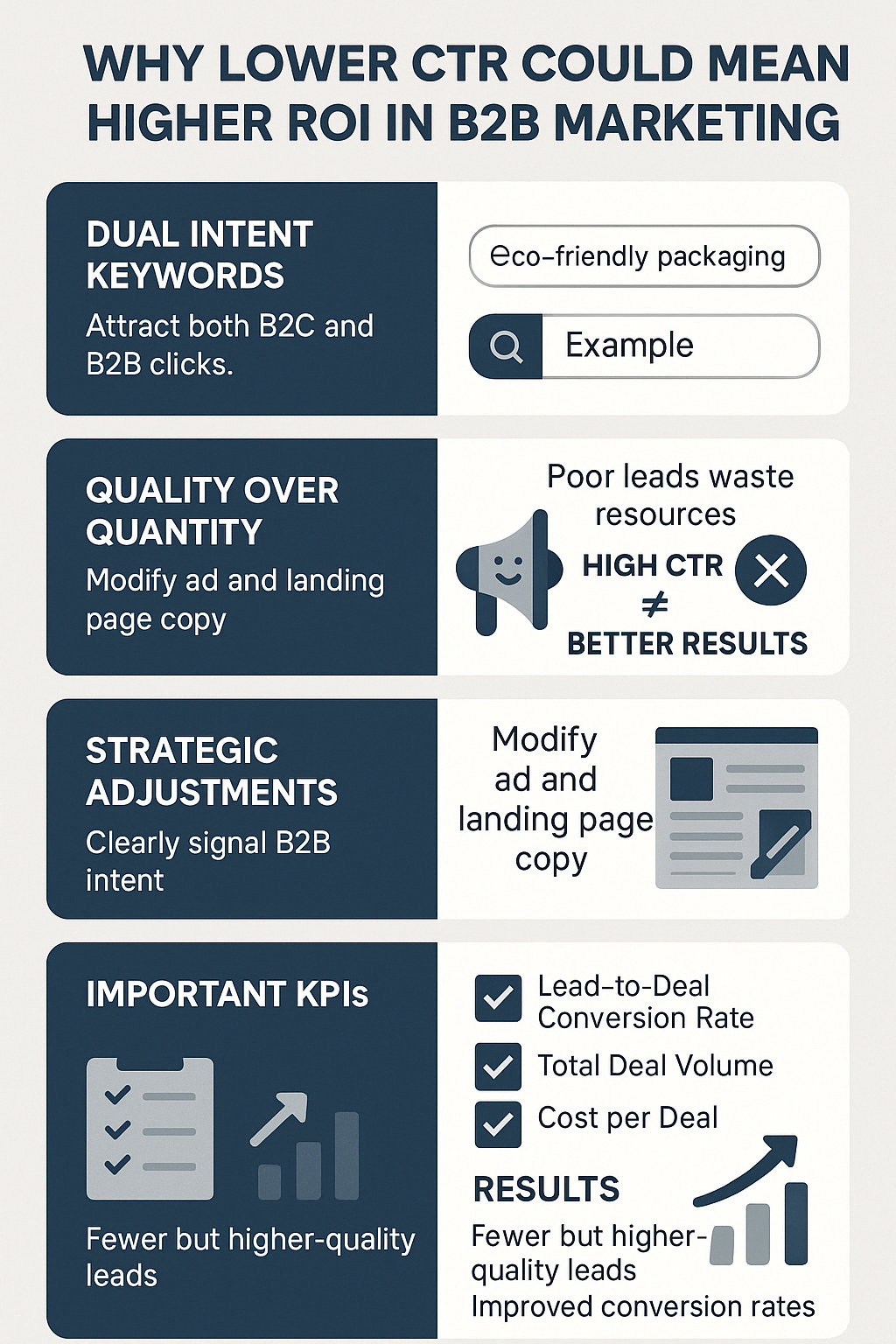When managing paid media campaigns, marketers typically celebrate higher click-through rates (CTR) and increased lead volumes. However, there are instances where deliberately lowering your CTR and lead volume can significantly enhance your campaign’s overall effectiveness, particularly in B2B marketing scenarios. Although it might initially seem counterintuitive, focusing on quality over quantity can lead to better long-term outcomes.
Understanding Dual Intent Keywords
One of the core challenges many marketers face, especially those managing B2B campaigns, is navigating keywords with dual intent—keywords that attract both business-to-consumer (B2C) and business-to-business (B2B) searchers. For instance, a term as seemingly straightforward as “eco-friendly packaging” can attract individual consumers looking for personal-use products as well as business decision-makers searching for commercial bulk packaging solutions.
When both consumer and business audiences intermingle within your campaign, you risk receiving numerous clicks and leads from consumers who aren’t actually interested in your offering, resulting in wasted budget and diluted ROI.
The Case for Reducing CTR and Lead Volume
Let’s explore a real-world scenario where this issue occurred. I recently encountered a situation where a client’s paid search campaign was generating numerous clicks and leads but not translating into actual business deals. Upon investigation, it became clear that many leads came from individual consumers rather than targeted business decision-makers.
To rectify this, we strategically modified both our ad copy and landing page content to clearly emphasize the B2B nature of our offerings. The language was adjusted to clearly signal to individual consumers that our product was tailored specifically for businesses and bulk orders, rather than personal or retail-level purchases.
Immediate Effects of Copy Adjustments
Following these adjustments, we observed a noticeable decrease in CTR and overall lead volume. At face value, these metrics might suggest that our campaign performance was declining. However, the primary aim was precisely this—to deter low-quality leads that were unlikely to convert into profitable business relationships.
Initially, seeing these core metrics decrease can be unsettling, especially when most marketers traditionally associate performance with high click volume and high engagement. However, this strategic refinement quickly demonstrated a clearer path to achieving genuine business results.

The Real KPIs to Monitor
Rather than obsessing over immediate click-through rates or raw lead numbers, it’s crucial to refocus on metrics that directly tie back to business outcomes:
- Lead-to-Deal Conversion Rate:
- How many of the leads actually turn into paying customers?
- Total Deal Volume:
- What is the total number of deals resulting from your campaign?
- Cost Per Deal:
- How much money are you spending to close each deal?
By shifting focus to these KPIs, marketers can better gauge the effectiveness of their campaigns. A lower CTR and lead volume can be favorable if those metrics accompany a higher conversion rate, increased deal volume, and reduced cost per deal.
Evaluating Long-term Success
Although our adjustments initially reduced click and lead volume, the quality of those leads significantly improved. Leads coming into the pipeline became more relevant, aligning closely with the client’s business objectives.
The consequence was higher-value interactions, deeper engagement with prospects genuinely interested in bulk business deals, and, ultimately, a better overall ROI. This illustrates the importance of prioritizing quality interactions over sheer quantity in B2B marketing.
Applying These Lessons to Your Campaigns
To implement a similar strategy:
- Review your current keywords for dual intent possibilities and potential sources of low-quality traffic.
- Adjust ad copy and landing pages to more explicitly target your ideal audience and deter unintended clicks.
- Set clear KPIs focusing on quality and business outcomes rather than surface-level engagement metrics.
- Monitor and refine your strategy continuously based on performance insights related to lead quality and sales conversions.
Sustainability and Supplier Alignment
It’s also vital to ensure that your campaign aligns with your broader sustainability and corporate responsibility goals. Selecting suppliers and partners that genuinely back their sustainability commitments adds another layer of quality and integrity to your campaigns, enhancing your brand reputation and attractiveness to your target B2B audience.
In summary, don’t be afraid to purposefully reduce your CTR and lead volume if doing so filters out irrelevant clicks and attracts higher-quality prospects. Refine your messaging, align your ads more closely with your true business goals, and focus on metrics that matter most to your bottom line.
Ultimately, a smaller number of high-quality leads is more valuable than a large volume of unqualified clicks, making your marketing spend smarter and your business outcomes significantly better.

Hi there! I’m Scott, and I am the principal consultant and thought leader behind Stratus Analytics. I have a Master of Science degree in marketing analytics, and I’ve have been providing freelance digital marketing services for over 20 years. Additionally, I have written several books on marketing which you can find here on Amazon or this website.
DISCLAIMER: Due to my work in the packaging industry, I cannot take on freelance clients within the packaging manufacturing space. I do not want to provide disservice to your vision or my employer. Thank you for understanding.
